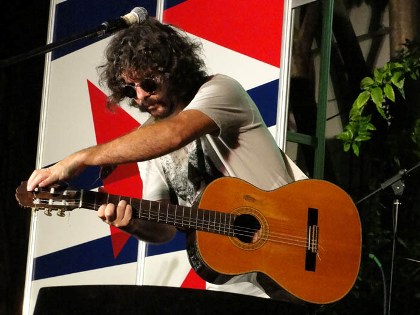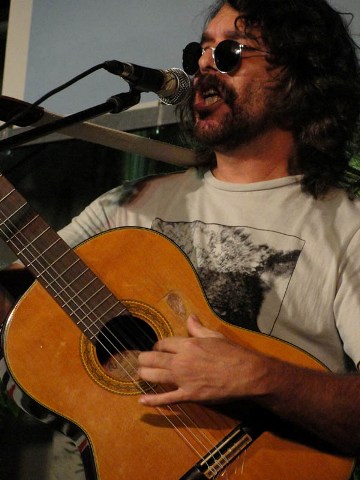Santiago Feliu: Musical Bridge from Cuba
A Musical Bridge from Cuba (*)
Osmel Almaguer

HAVANA TIMES, Oct. 28 — Santiago Feliu is a member of the Nueva Trova movement, though due to generational affinities he has been identified as part of the later Novisima Trova movement.
A singer, guitarist, producer and composer, Feliu has also mastered the bass, drums, various smaller percussion instruments, the piano and the harmonica.
As a pupil of Silvio Rodriguez and an apprentice of the friends of his brother, Vicente Feliu, music came into his life at an early age. By thirteen he already knew many of the musicians who would later accompany him on stage.
He began by holding the guitar in a right-handed position, despite his being left-handed, with this serving as the basis for his unique and innovative melodies. He is an impassioned fan of the cinema; through it he escapes the charged atmosphere of his home.
A reader of classics such as Herman Hesse, Michael Ende and Franz Kafka, whose works permeate the his song’s lyrics, he’s also listens to the grand exponents of European classical music (Beethoven, Mozart, etc.) as well as Juan Formell, branded by some the “Mozart of Cuba.”
Someone once called him “a hippie of communism,” and I believe one could find no better way to define his spirit. From melancholy to hope, discovering poetry in what surrounds him, he is usually heard by those who want him to speak to them – people who share his existential pain and the weight implied by understanding history.
His leftist orientation appears well metabolized in the words of his songs, which are far removed from being political tracts, but come closer to the sense of life, to a human existence, to history and questions such as the meaning of revolution, evolution or war – or all at the same time.
His most well know song —a true classic of Cuban Trova— is titled “Para Barbara” (For Barbara), and was inspired by a marriage that lasted only eight months. From it was born his son Adriano, who is now a part of the “Novisima” song movement.

The guitar work introduced in his music, transcends any mere accompaniment of the songs of this troubadour. And with his harmonica he emphasizes the feelings he wishes to express, on occasion executing moving solos between each verse.
He has recorded the CDs Vida (1986), Trovadores (1987), Para mañana (1988), Nauseas de Fin de Siglo (in the studio, 1991), Nauseas de Fin de Siglo (live, 1994), Ansias del Alba (with Vicente Feliu, 1997), Futuro Inmediato (1999), Santiago Feliu (live, 2000), Entre Otros (along with Noel Nicola, 2002), Sin Julieta (2002) and Ay, La Vida (2010)
“Para Barbara”
CD Nauseas de Fin de Siglo
The lyrics of this song are full of poetry. The sense of the words attempt a voyage to the infinite, to a cosmovision, to a state of universal acknowledgement, born of a short but clearly very intense relationship with his former wife.
I feel your gleam drowning out my breeze / my breeze that I feel is inexhaustible, blue, infinite / a limpid breeze / of inexhaustible lyricism / whispering my dreams / that in my verse / are released.
If from my voice flourishes / the song / the motive / to give to you / if from your eyes is born / the kindness / to open myself in verse / a beat of my heat / then don’t let me leave.
The lyrics unfold without telling a story. Rather, they create an allegory, an approach to the inspiration that certain things or people produce in us or an approach to the feedback to dialogue that we usually have with them.
But this relationship is not always positive, it doesn’t advance evenly. Instead, it is plagued with contradictions. A gleam, if it’s too strong, can produce momentary blindness in the observer.
It happens this way to each and everything in this world. Everything has positive and negative aspects.

That gleam drowns its breeze, though it might seem like nonsense if we try to understand it in a direct sense. Nevertheless it involves a poetic resource known as a stimulant that awakens, and through which there is one sense (in this case that of vision) that becomes associated with another to create an effect of beauty and/or to communicate a feeling, an idea or an impression.
When Santiago speaks of Barbara, he seems to be speaking to the creation itself, which is what provokes, through that contradiction already mentioned, the state of inspiration and harmony with the world.
This is why the song is born with that kindness to “let your heart open and beat” (meaning to provoke feelings), and that is like whispering or blowing air, something elusive that leaves the sensation of having gone away without having left one’s best definition.**
However his relationship with Barbara (or his muse) doesn’t flow in a single direction. The singer’s gleam also drowns her breeze, which is inexhaustible, and like his is also blue, infinite, when he vents them through the song.
This is why the songwriter doesn’t consider his voice to be private property, but rather the result of a relationship with creation, with the woman, with the world and with life. So he is somehow transformed from being the creator to the created, and he asks her in this song of his (which is no longer so much his but also hers and everyone’s) that she not let this necessary and vitally important moment escape.
The relationship with his wife is changed based on the inspiration generated by this song, which has been part of all of us, because Santiago dreamed of it this way.
** A reference to the poem by Jose Lezama Lima “Ah, que tú escapes” (in the moment in which he left his best self-definition) concerning the very act of poetic creation.
—
(*) A Musical Bridge from Cuba: This is an effort to find new bridges that promote communication between peoples of the diverse regions of the planet. I will be using simple narration in a series of articles to connect with those who are interested in the messages transmitted by Cuban songs, which due to their limited commercial potential and the difficulties posed by their translation, languish in a state of communicational stagnation – despite their being true jewels of Cuban culture.
